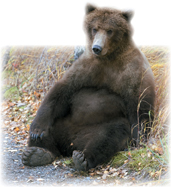At this point, the runners' muscle cells are producing most of their ATP by lactic acid fermentation, which can usually supply enough ATP to last about 90 seconds. In a 200- or 300-meter sprint, this may be just enough to reach the finish line.
Fermentation produces lactic acid as a byproduct. When the race is over, the only way to get rid of lactic acid is in a chemical pathway that requires extra oxygen. For that reason, you can think of a quick sprint as building up an oxygen debt that a runner has to repay with plenty of heavy breathing after the race. An intense effort that lasts just 10 or 20 seconds may produce an oxygen debt that requires several minutes of huffing and puffing to clear.  For short, quick bursts of energy, the body uses ATP already in muscles as well as ATP made by lactic acid fermentation.
For short, quick bursts of energy, the body uses ATP already in muscles as well as ATP made by lactic acid fermentation.
Long-Term Energy What happens if a race is longer? How does your body generate the ATP it needs to run 2 kilometers or more, or to play in a soccer game that lasts more than an hour?  For exercise longer than about 90 seconds, cellular respiration is the only way to continue generating a supply of ATP. Cellular respiration releases energy more slowly than fermentation does, which is why even well-conditioned athletes have to pace themselves during a long race or over the course of a game. Your body stores energy in muscle and other tissues in the form of the carbohydrate glycogen. These stores of glycogen are usually enough to last for 15 or 20 minutes of activity. After that, your body begins to break down other stored molecules, including fats, for energy. This is one reason why aerobic forms of exercise such as running, dancing, and swimming are so beneficial for weight control. Some organisms, like the bear in Figure 9–10, count on energy stored in fat to get them through long periods without food.
For exercise longer than about 90 seconds, cellular respiration is the only way to continue generating a supply of ATP. Cellular respiration releases energy more slowly than fermentation does, which is why even well-conditioned athletes have to pace themselves during a long race or over the course of a game. Your body stores energy in muscle and other tissues in the form of the carbohydrate glycogen. These stores of glycogen are usually enough to last for 15 or 20 minutes of activity. After that, your body begins to break down other stored molecules, including fats, for energy. This is one reason why aerobic forms of exercise such as running, dancing, and swimming are so beneficial for weight control. Some organisms, like the bear in Figure 9–10, count on energy stored in fat to get them through long periods without food.
MYSTERY CLUE

Whales rely on lactic acid fermentation for much of their energy requirements during a deep dive. If they can't inhale to repay their oxygen debt, what are they doing with all of the lactic acid produced by fermentation?

FIGURE 9–10 Energy Storage Hibernating animals like this brown bear in Alaska rely on stored fat for energy when they sleep through the winter. Predict How will this bear look different when it wakes up from hibernation?
9.3 Assessment

-
Review Name the two main types of fermentation.
Compare and Contrast How are alcoholic fermentation and lactic acid fermentation similar? How are they different?
-
Review Why do runners breathe heavily after a sprint race?
Sequence List the body's sources of energy in the order in which they are used during a long-distance race.
PRACTICE PROBLEM
You have opened a bakery, selling bread made according to your family's secret recipe. Unfortunately, most customers find the bread too heavy. Review what you have learned about chemical reactions in Chapter 2 and make a list of factors such as temperature that might affect the enzyme-catalyzed fermentation reaction involved in baking bread. Predict how each factor will affect the rate of fermentation and propose a solution for making the bread lighter by adding more bubbles to your family bread recipe.

Table of Contents
- Formulas and Equations
- Applying Formulas and Equations
- Mean, Median, and Mode
- Estimation
- Using Measurements in Calculations
- Effects of Measurement Errors
- Accuracy
- Precision
- Comparing Accuracy and Precision
- Significant Figures
- Calculating With Significant Figures
- Scientific Notation
- Calculating With Scientific Notation
- Dimensional Analysis
- Applying Dimensional Analysis




